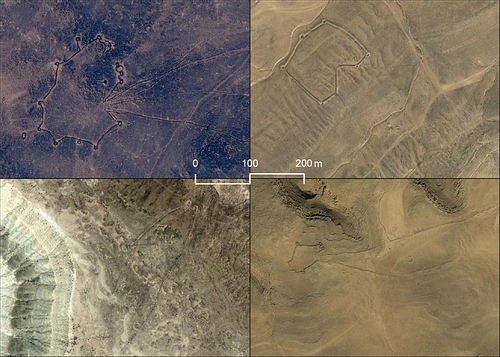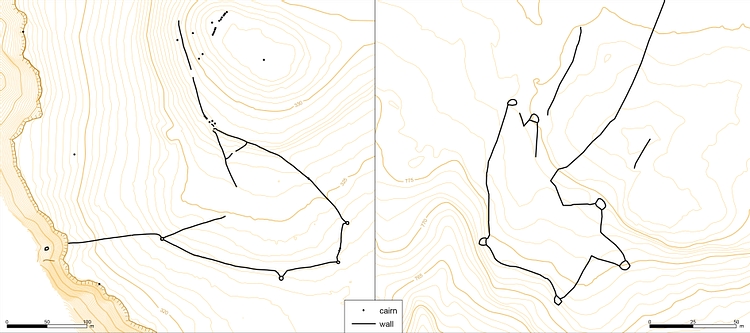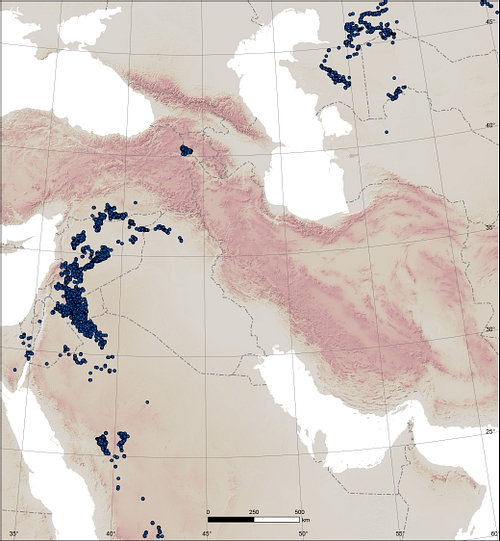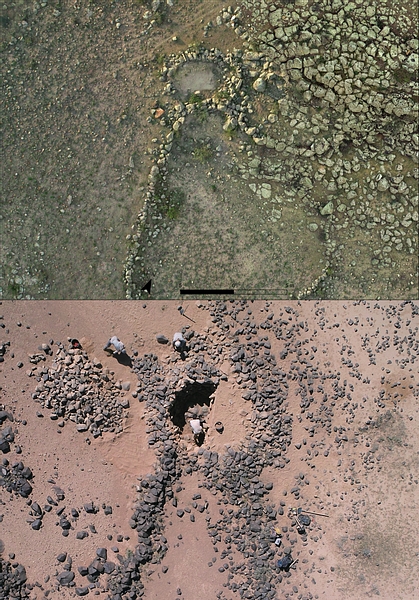
Desert kites are mega-constructions that consist of two long walls converging upon an enclosed space that has on its periphery small stone constructions called cells. Seen from the sky, their shape suggests that of a windborne kite; they were thus called kites by pilots who flew over the arid regions of the Near East in the time of the French and British mandates of the first half of the 20th century CE. These kites combine various characteristics which in archaeology have been the object of particular research. However, most classical methods of investigation are useless because of the nature of these constructions.
In spite of many studies, kites remain a mystery in many respects, although recent research has advanced their knowledge. We are beginning to better understand their geographic extension, their age and their function, crucial questions still under discussion a short time ago. From the beginning of the 2010s CE, the access to high-resolution satellite images stimulated research by revealing that there are many more kites than were thought a few years ago. From this new data source and more classical information, multidisciplinary investigations were launched in conjunction with the organization of field expeditions.
Morphological Description
Kites are large archaeological remains, generally quite well preserved. They are dry stone constructions, composed of an enclosure and more or less continuous walls which converge towards an entrance; these walls can sometimes be absent but are usually two in number and sometimes three, four or more. Their length is commonly several hundred meters and can even reach several kilometres, while their height is no more than a few decimetres. The enclosures are variable in shape (circular, triangular, star-shaped, etc.) and their size, far larger than pastoral enclosures, varies from a few hundred square meters to more than ten hectares.
The small stone constructions or cells that are joined to the external part of the enclosure are the most sophisticated part of the device, always carefully constructed. Their number varies from a single cell to several dozen. The variability among the kites makes it difficult to propose a typology. Several often-observed attributes are considered, such as a disposition of the cells near the entrance, the existence of cells at the extremity of pointed appendices and the particular shapes of the entrance. These features are most often shared by kites from the same region, thus forming homogeneous groups circumscribed at the regional scale. Kites are found in arid environments, steppes and desert margins and their topographical location is clearly the result of a definite choice. A break in the slope is the most often observed at the position of the entrance and various topographic configurations were preferred to flat topography.
Geographical Distribution
The principle of an enclosure at the extremity of converging walls appears to be universal in character, as constructions of this type are found in several regions of the world (North and South America, Scandinavia, etc.). However, kites are distinguished from other constructions by the presence of cells adjoining the enclosure.
The first kites identified in the past, and the most numerous, are located in the Harrat-al-Sham, the “Black Desert” between Syria and Jordan. There are other zones of high density, but these are more circumscribed: in the mountains of Palmyra in Syria, in the Harrat Khaybar in western Saudi Arabia and recently discovered in Armenia. Other regions contain kites that are more dispersed, although they are rarely isolated and are usually grouped together: in the regions of Damascus and Qaratein, in
the Jebel al Has, and on the plateau of Hemma in Syria.
In Arabia, they are also found in the northern margins of the Nefud, in the prolongation of the Harrat al-Sham. An important group was recently discovered in the southern foothills of the Taurus in southern Turkey. Another important group, long known to local archaeologists, is situated on the Ustyurt Plateau, in the Aralo-Caspian zone in Kazakhstan and Uzbekistan. In total, the most recent inventory (summer 2020 CE) includes more than 6000 kites which therefore extend over a considerable
geographical area. This inventory from the globalkites project is regularly updated.
Function
It was generally agreed that kites served to gather together animals, but opinions were divided on the question of whether the herds were wild or domestic. Recent excavations of cells - these small constructions that define the kites - showed that they were systematically pit-traps, generally deep, intended to entrap the animals there. It is therefore the killing device, the rest of the construction used to concentrate and direct the prey. We have no information on how the hunt was carried out (number and role of hunters, timing, use of dogs, etc.), but high-resolution topographic surveys have made the general operating of the trap more intelligible.
The complex topography in which the enclosures are built and their size make the trap almost invisible from the inside, in an environment similar to that from the outside. The slope break at the entrance served to conceal the presence of the enclosure for the animals in their displacement. The same principle was often used to hide the cells / pit-traps, which were often constructed at the end of a pointed appendage, until the animals fell into it. The plan of the enclosures has often numerous points, appendages at the end of which are hidden the cells / pit-traps. So, even if it was possible for animals to jump over walls, the general shape of the device was designed to direct them towards the pits.
Wild ungulates are sensitive to alignments in their rapid herd movements and were probably hunted during their seasonal migrations. It is indeed observable that, in a given region, kites are oriented towards a preferential direction, despite having directional variability, which can be explained by the orientation of the local topography. Now mostly extinct, the gazelle bones found in archaeological sites show that this species was present throughout the geographical range of kites (without a relationship being established between the sites and the kites); due to its herd behavior, it was likely the most coveted species, even if other species are possible.
Dating
The dating of kites has long remained unclear - and this uncertainty remains to some extent - because archaeological material is absent from the rare excavations of them: the remains of tools, traces of use, and animal bones are absent, while carbonised materials suitable for dating are rare. In the 1990s CE, the excavation of a kite in southern Syria and relative dating was consistent with the early Bronze Age. This corroborated a significant number of dates also established in the 1980s CE and the 1990s CE for several traps in the Negev, even if these kites of a very particular morphology are not representative of kites in general. Based on relative chronology and/or on artefacts found on the surface, two authors were in agreement that the kites of the Harrat al-Sham in Jordan correspond to the end of the Neolithic. Finally, there were several travellers' accounts between the 17th and 19th centuries CE that describe collective hunting of gazelles in the Near East, but it is not certain that the structures described correspond to the kites we observe today.
Until recently, the chronological clues were few, and the cases analyzed were often singular. However, several excavations undertaken in recent years have allowed more numerous and well-contextualized dating (radiocarbon of charcoal, calcified seeds or bird eggshell, OSL/IRSL of sediments). In Armenia, the kites were used between the end of the Bronze Age until the beginning of the Common Era. On the Ustyurt plateau in the Aralo-Caspian zone, the kites go back to the Iron Age and persisted until most recently. In the south of Jordan, following the excavation of several kite cells, dates from the end of the Neolithic have been attested. Already suspected by previous results, recent dates attest the use or construction of kites over a very long time span.
Conclusion
Kites are unique very large hunting traps. The cell/pit-trap is indeed the killing device which has no equivalent in other large trap systems documented around the world. This singularity and the number of kites built over a period of about ten millennia, over a considerable geographic range, suggests a phenomenon of cultural diffusion of very long duration which remains to be documented. Many questions arise and invite interesting avenues of research: who were the kite builders, what was their way of life and their probable relationships with the neolithicized and then urbanized populations? Some questions echo modern ones: having possibly played a role in the disappearance of the great herds, were these hunters responsible for ancient biodiversity loss? Or, on the contrary, did they manage their hunting sustainably, adapting their activities to the changes that occurred in these fragile environments?









